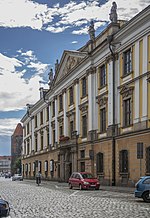Church of St. John the Baptist in Legnica
Baroque church buildings in PolandBuildings and structures in LegnicaBurial sites of the Piast dynastyChurches in Lower Silesian VoivodeshipRoman Catholic churches in Poland

The Church of St. John the Baptist in Legnica is a Baroque church in Legnica, Poland, built in the first half of the 18th century.
Excerpt from the Wikipedia article Church of St. John the Baptist in Legnica (License: CC BY-SA 3.0, Authors, Images).Church of St. John the Baptist in Legnica
Ojców Zbigniewa i Michała, Legnica
Geographical coordinates (GPS) Address Phone number Website External links Nearby Places Show on map
Geographical coordinates (GPS)
| Latitude | Longitude |
|---|---|
| N 51.208888888889 ° | E 16.158611111111 ° |
Address
Kościół pw. Świętego Jana Chrzciciela
Ojców Zbigniewa i Michała 1
59-220 Legnica
Lower Silesian Voivodeship, Poland
Open on Google Maps











